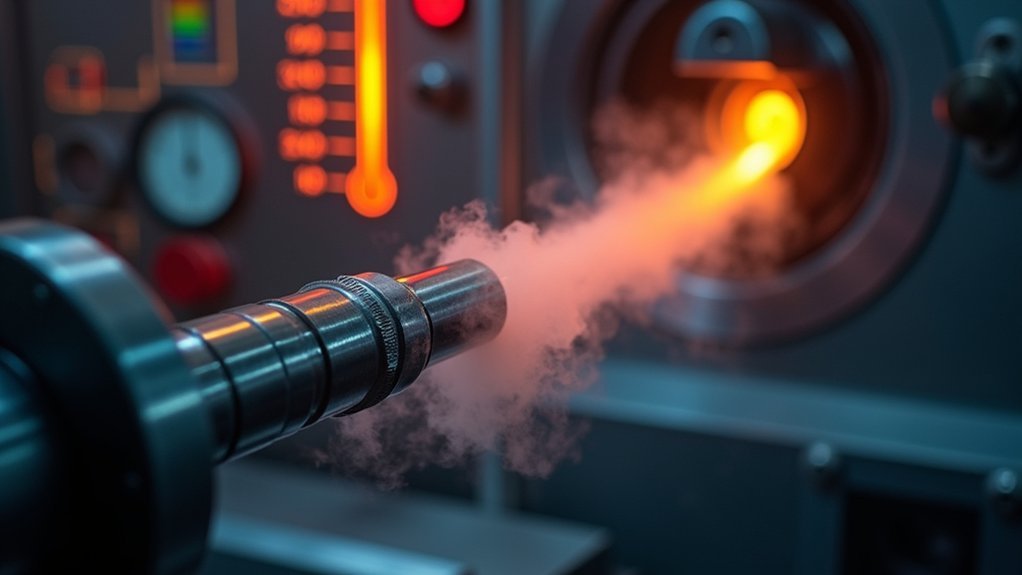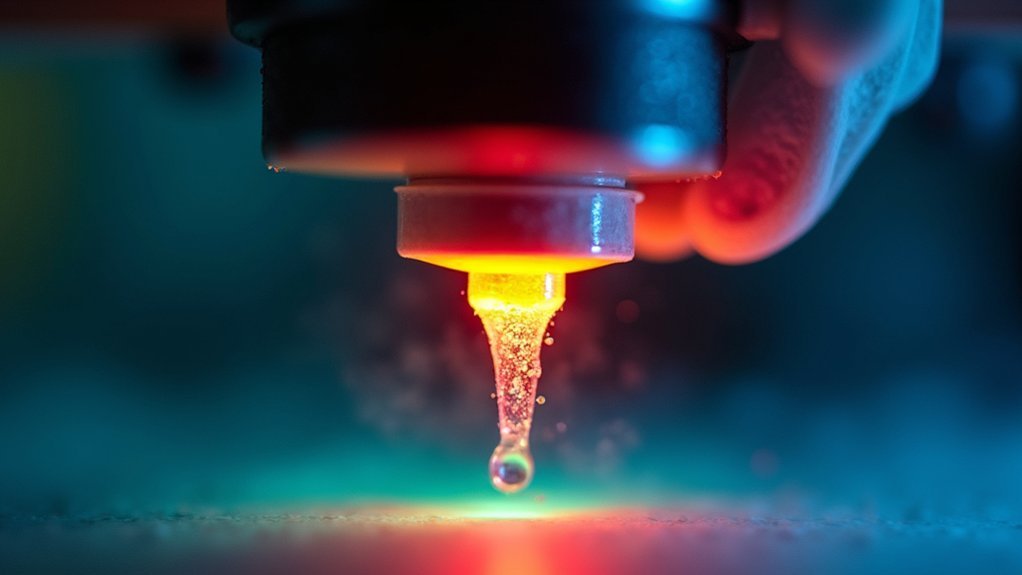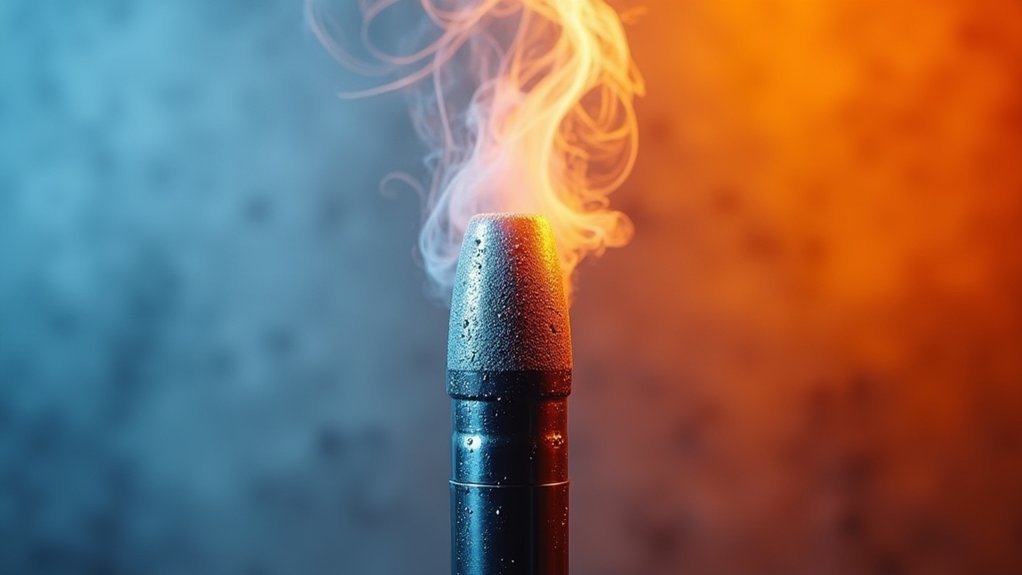Temperature changes markedly impact your nozzle performance by altering material viscosity and flow rates. When it’s hot, your ink viscosity decreases, improving flow but risking print accuracy, while cold conditions can increase viscosity by up to 20% with just a 10°C drop. Thermal expansion also changes your nozzle’s internal diameter, reducing output pressure and creating non-uniform flow patterns that compromise print quality. Understanding these seasonal effects will help you optimize your printing setup.
How Ambient Temperature Fluctuations Impact Extruder Consistency

When ambient temperature fluctuates around your extruder, it directly alters the viscosity of your materials and disrupts the consistency of your extrusion process.
You’ll notice that higher temperatures decrease viscosity in low-viscosity food inks like gelatin solutions, improving flow characteristics but potentially compromising your print accuracy.
Temperature regulation becomes critical since these fluctuations increase evaporation losses, affecting your ink’s rheological properties and creating inconsistent deposition patterns.
Temperature fluctuations during extrusion cause evaporation losses that alter ink rheology and create irregular deposition patterns.
You can minimize defects by maintaining stable ambient conditions around your equipment.
Proper extruder design that optimizes heat transfer characteristics will enhance your printed material’s mechanical properties.
Without consistent temperature control, you’ll experience variations in product quality that compromise your overall extrusion performance and printing reliability.
Material Flow Rate Changes During Summer and Winter Months
You’ll notice dramatic shifts in your material flow rates as seasons change, with summer’s heat reducing viscosity and boosting throughput while winter’s cold creates the opposite effect.
These seasonal temperature swings don’t just alter flow patterns—they trigger thermal expansion in your nozzle components that can further disrupt consistency.
Understanding how these three factors interact becomes critical when you’re trying to maintain stable extrusion performance year-round.
Seasonal Temperature Impact Analysis
As temperatures fluctuate between summer and winter months, your nozzle’s material flow rates will experience dramatic variations that can make or break operational efficiency.
The temperature gradient creates a direct correlation with material viscosity – you’ll see enhanced nozzle flow during warmer summer periods when reduced viscosity allows materials to move more freely. Conversely, winter’s chill increases viscosity by up to 20% with just a 10°C drop, creating potential blockages and reduced flow rates.
You’ll also notice higher pressure differentials in colder conditions, requiring additional energy input to maintain consistent performance.
Seasonal thermal expansion and contraction further complicate matters by altering nozzle dimensions and tolerances, creating performance inconsistencies that demand proactive adjustments to your operating parameters throughout the year.
Flow Rate Variance Patterns
These seasonal impacts create measurable flow rate variance patterns that follow predictable cycles throughout the year.
You’ll notice your nozzle’s performance shifts dramatically as temperature difference between seasons affects material properties and Reynolds number calculations.
Here’s what you can expect throughout the year:
- Summer months deliver increased flow rates due to reduced material density from higher temperatures
- Winter conditions create higher viscosity, leading to decreased flow rates through your nozzle
- Thermal expansion alters your nozzle’s geometric configuration, impacting flow characteristics
- Ideal flow rates can shift up to 15% between seasons for the same materials
- Heat transfer dynamics within the nozzle change, affecting overall extrusion efficiency
You’ll need to adjust your process parameters seasonally to maintain consistent performance and product quality.
Thermal Expansion Effects
While seasonal temperature fluctuations might seem negligible, thermal expansion creates considerable changes in your nozzle’s internal dimensions that directly impact material flow rates.
During summer months, rising temperatures cause your nozzle materials to expand, creating tighter clearances that restrict flow and reduce performance. Common materials like aluminum, with its coefficient of 22 x 10⁻⁶/°C, demonstrate how even small temperature changes considerably affect dimensions.
Winter brings the opposite effect—material properties shift as components contract, creating larger gaps that can increase flow rates but also risk leaks and inefficiencies.
You’ll notice these dimensional changes affect not just the nozzle assembly but also fluid viscosity, which increases in colder temperatures and further reduces flow rate.
Understanding thermal expansion helps you anticipate and compensate for seasonal performance variations.
Thermal Expansion Effects on Nozzle Diameter and Output Quality
When temperatures rise in nozzle systems, thermal expansion directly impacts the internal diameter, creating a cascade of performance changes that you’ll need to account for in your design.
Thermal expansion in nozzle systems creates cascading performance changes that directly impact internal diameter and require careful design consideration.
As your nozzle diameter enlarges from thermal expansion, you’ll experience reduced output pressure and altered velocity profiles.
Here’s what happens to your system:
- Mass flow rates decrease as the larger diameter reduces velocity output for given pressure differences
- Material deformation creates structural irregularities that compromise gas output quality
- Non-uniform flow patterns develop, affecting overall system performance
- Spray patterns become inconsistent with varying droplet sizes in atomization applications
- Output quality suffers from thermal-induced variations in flow characteristics
Understanding these thermal expansion effects on nozzle diameter and output quality becomes essential when you’re optimizing high-temperature applications like combustion systems or propulsion engines.
Hotend Heating Element Performance Across Temperature Seasons

You’ll notice your hotend heating element’s performance shifts dramatically as ambient temperatures change throughout the year, directly affecting your printer’s thermal efficiency and material extrusion consistency.
During colder months, your heating element must work harder to reach target temperatures, while summer heat can cause overheating issues that compromise temperature regulation.
These seasonal variations create efficiency fluctuations that you must account for when calibrating your printer’s thermal settings for peak performance.
Seasonal Temperature Impact Analysis
As ambient temperatures drop during winter months, your 3D printer’s hotend heating element faces increased thermal demands that directly impact extrusion performance.
The nozzle operates within a complex temperature field where seasonal variations create measurable efficiency changes.
Your heating element’s heat exchange efficiency decreases as ambient temperatures fall, requiring strategic adjustments:
- Power consumption increases 5-10% for every 10°C ambient temperature drop
- Heat-up times extend considerably during cold weather printing sessions
- Material viscosity changes affect flow rates through the nozzle
- Thermal insulation effectiveness reduces, causing greater heat loss
- Temperature overshooting becomes common as systems compensate for slower responses
You’ll notice these effects most prominently when printing high-temperature materials like ABS or PETG, where consistent heat exchange becomes critical for maintaining proper extrusion rates and print quality throughout seasonal changes.
Heating Element Efficiency Variations
Beyond these observable performance changes, your hotend’s heating element experiences fundamental efficiency variations that compound seasonal challenges. Winter’s cold ambient temperatures force your heating element to work harder, reducing overall efficiency as heat transfer becomes less effective. Your element’s thermal conductivity fluctuates with seasonal temperature swings, directly impacting response time and heat distribution uniformity across the nozzle.
| Season | Efficiency Impact | Temperature Response |
|---|---|---|
| Winter | Decreased 15-20% | Slower heating cycles |
| Spring | Moderate variation | Standard performance |
| Summer | Risk of overheating | Faster heat buildup |
| Fall | Gradual efficiency loss | Periodic instability |
You’ll need regular calibration adjustments to maintain ideal 200°C-250°C operating ranges. Summer heat can push temperatures beyond safe thresholds, causing filament degradation, while winter conditions require extended warm-up periods for consistent performance.
Print Speed Adjustments Required for Different Room Temperatures
When room temperature fluctuates during 3D food printing, you’ll need to adjust your print speeds to compensate for changes in ink viscosity and flow characteristics.
Low-viscosity food inks become even thinner as temperatures rise, affecting extrusion consistency and requiring precise speed modifications.
Here’s how to optimize your print speed based on room temperature:
- 21°C to 25°C range: Maintain standard speeds that align with your gelatin-based ink’s rheological properties
- Lower temperatures: Reduce print speed to accommodate increased viscosity and prevent nozzle clogging
- Higher temperatures: Increase speed to minimize evaporation losses and maintain print fidelity
- Continuous monitoring: Track both nozzle and ambient temperatures throughout printing
- Layer adhesion: Adjust speeds to guarantee proper bonding between successive layers for structural integrity
Layer Adhesion Problems Caused by Seasonal Climate Variations

Seasonal climate variations create significant challenges for maintaining consistent layer adhesion in 3D food printing, as fluctuating temperatures and humidity levels directly alter your ink’s bonding properties. When winter’s cold increases your ink’s viscosity, you’ll struggle with poor layer bonding that creates structural weaknesses. Summer’s humidity compounds these issues by changing your food ink’s composition and affecting nozzle extrusion.
| Season | Temperature Challenge | Layer Adhesion Impact |
|---|---|---|
| Winter | Increased viscosity | Weak bonding between layers |
| Spring | Temperature fluctuations | Inconsistent adhesion quality |
| Summer | High humidity effects | Altered ink properties |
| Fall | Cooling changes | Variable flow characteristics |
| Year-round | Climate instability | Structural failures |
Effective temperature regulation between 21°C and 25°C becomes essential for maintaining ideal rheological behavior and preventing adhesion failures across seasons.
Filament Viscosity Modifications Under Varying Environmental Conditions
Although your food ink’s viscosity remains stable in controlled laboratory conditions, environmental temperature fluctuations dramatically alter its flow characteristics during actual printing operations.
When you’re working with gelatin-based inks, experimental results show dramatic viscosity changes between 25–33°C that directly impact your extrusion quality.
Temperature variations affect your printing success through several mechanisms:
Multiple temperature-related factors create complex challenges that directly impact your 3D food printing outcomes and require careful management.
- Ambient temperature shifts reduce filament viscosity as heat increases, improving flow but potentially compromising structural integrity.
- Nozzle heat loss creates inconsistent temperature gradients that disrupt smooth material deposition.
- Seasonal climate changes alter your workspace conditions, requiring constant recalibration of printing parameters.
- Pseudoplastic behavior means your gelatin’s shear-thinning properties become more pronounced at higher temperatures.
- Poor temperature control leads to unpredictable extrusion rates and failed print jobs requiring immediate intervention.
Cooling Fan Efficiency Changes Throughout the Year
Your cooling fan’s performance fluctuates dramatically as seasons change, creating unexpected challenges for maintaining consistent print quality.
During warmer months, you’ll notice decreased cooling fan efficiency as higher ambient temperatures increase air density and reduce airflow effectiveness. The heat also affects your fan motor’s lubricants, increasing viscosity and friction that further diminishes performance.
Spring and fall offer ideal conditions when moderate temperatures allow your cooling system to operate at peak efficiency. You’ll experience improved airflow and reduced energy consumption during these seasons.
Numerical simulation studies confirm that fans with variable speed controls maintain better performance year-round by automatically adjusting to temperature variations.
Without proper compensation for seasonal changes, your print quality may suffer from inadequate cooling during critical extrusion phases.
Heat Creep Prevention Strategies for Warm Weather Printing
When ambient temperatures rise above 75°F, heat creep becomes your printer’s most formidable enemy, causing filament to soften prematurely in the cold end and creating devastating clogs that’ll ruin your prints.
You’ll need aggressive thermal management strategies to combat this threat:
- Install PID controllers for precise temperature regulation around your nozzle structure
- Deploy ambient cooling systems like cooling boxes or strategically positioned fans
- Add water circulation channels within your nozzle structure for enhanced heat dissipation
- Mount temperature sensors on both filament and nozzle for real-time monitoring
- Adjust printing parameters dynamically based on sensor feedback
These modifications work together to maintain stable temperatures and prevent heat creep from sabotaging your prints during sweltering summer sessions.
Cold Weather Challenges for Heated Bed and Nozzle Synchronization
When cold weather strikes, you’ll face significant temperature gradient control issues between your heated bed and nozzle that can throw off their synchronization.
You’ll need to implement effective heat loss prevention methods since the ambient temperature drop forces both components to work harder to maintain ideal temperatures.
Your printer’s thermal stability becomes compromised as the nozzle and bed struggle to reach and maintain their target temperatures simultaneously.
Temperature Gradient Control Issues
Although ambient temperatures may seem like a minor factor, cold weather creates significant synchronization challenges between your heated bed and nozzle that can derail even the most carefully calibrated 3D printing setup.
Temperature gradients between these components disrupt your printer’s thermal performance, causing timing mismatches that affect material flow and adhesion. Cold air increases the convective heat transfer coefficient around your nozzle, accelerating heat loss and creating inconsistent extrusion patterns.
Key gradient control issues include:
- Uneven heating cycles between bed and nozzle components
- Delayed thermal stabilization affecting print start timing
- Inconsistent material viscosity due to fluctuating temperatures
- Poor layer adhesion from mismatched component temperatures
- Premature material solidification disrupting synchronization
Effective insulation and ambient temperature control help maintain consistent thermal performance across all heating elements.
Heat Loss Prevention Methods
Three primary heat loss prevention strategies can dramatically improve your printer’s thermal stability in cold environments.
First, install thermal barriers around your heated bed and nozzle assembly to minimize heat dissipation. These barriers create insulation that maintains consistent temperatures during printing operations.
Second, implement PID controllers for precise temperature regulation. They’ll synchronize your heated bed and nozzle temperature, preventing fluctuations that cause poor adhesion and warping. You’ll need to maintain nozzle temperatures above 210°C for proper extrusion of low-viscosity food inks in cold conditions.
Third, construct a cooling box enclosure around your entire printer. This creates a controlled microenvironment that shields against ambient temperature variations.
Combined with proper heat loss prevention techniques, you’ll achieve reliable thermal synchronization between components, ensuring successful prints regardless of external weather conditions.
Thermal Runaway Risk Assessment During Extreme Temperature Periods
If you’re operating systems with lithium batteries during extreme temperature periods, you’ll face exponentially increasing thermal runaway risks that can compromise both performance and safety.
When temperatures exceed 60°C, you’re triggering accelerated chemical reactions that can lead to catastrophic failure, though incidents have occurred at temperatures as low as 45°C under specific conditions.
Your thermal management strategy becomes critical during these extreme periods:
- Monitor temperature gradients continuously to detect early warning signs
- Implement effective cooling strategies to maintain operational temperatures below 30-40°C
- Recognize that increased temperatures enhance internal resistance and heat generation
- Understand that thermal runaway likelihood increases exponentially with temperature
- Deploy proper thermal management systems to keep temperatures within safe operational limits
Preventive Maintenance Schedules Based on Seasonal Temperature Patterns
Beyond immediate thermal runaway concerns, you’ll need to establish maintenance schedules that account for seasonal temperature fluctuations affecting your nozzle systems.
During colder months, you should increase inspection frequency since temperature variations cause thermal contraction and potential blockages from solidified materials. These seasonal changes directly impact fluid flow by altering viscosity levels, requiring maintenance adjustments to maintain peak performance.
Cold weather demands more frequent nozzle inspections as thermal contraction and increased viscosity create blockages that compromise fluid flow performance.
You’ll want to schedule preventive maintenance checks before expected temperature extremes to address thermal expansion and contraction issues.
Analyze your historical performance data alongside seasonal temperature records to create customized maintenance schedules. This approach helps you identify specific thermal stresses your nozzles encounter throughout the year, allowing you to prevent failures and maintain consistent fluid flow regardless of seasonal temperature variations.
Frequently Asked Questions
Does Temperature Increase in a Nozzle?
You’ll typically see temperature increase in nozzles due to friction, combustion, or heat transfer from surrounding components. However, in expansion nozzles like rockets, you’ll experience temperature decrease as gas expands and accelerates.
How Do You Increase Nozzle Efficiency?
You’ll increase nozzle efficiency by implementing zoned designs, enhancing cooling mechanisms with PID controllers, using materials with tailored thermal properties, and regularly adjusting geometry through effusion holes or slits for ideal heat transfer.
What Happens if the Nozzle Temperature Is Too High?
You’ll experience thermal non-equilibrium that distorts flow properties, causes species transformation, triggers turbulence model failures, creates false thrust readings, and accelerates material wear that compromises your nozzle’s structural integrity.
Does Stagnation Temperature Change Across a Nozzle?
In ideal isentropic flow, you’ll find stagnation temperature remains constant across your nozzle. However, you’ll see changes in real applications due to friction, shock waves, and thermal conduction effects.





Leave a Reply